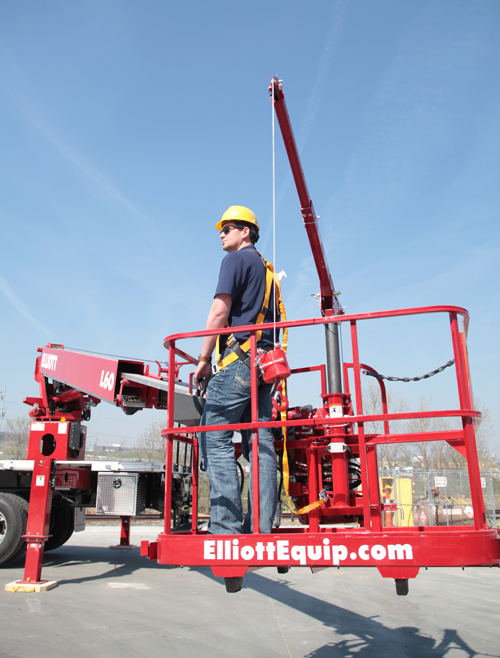When it comes to safely operating an aerial work platform or crane, nothing is more important than being knowledgeable about the equipment, proper planning of the operation and set up of the unit. A large number of accidents occur because of a deficiency in one of these areas.
For purposes of this article, we will assume that the machine is properly maintained, serviced and inspected per the manufacturer, OSHA and all applicable industry guidelines.
Know Your Job
The first step to a successful lift is to know what you are doing. To that end, before you operate any lifting device, you must be properly trained and certified (if applicable) to use the machine you will be working with. Today there are many places to obtain training and certification. If not performed with the proper planning, procedures, and personnel, aerial work platform and crane work can be hazardous.
Do not attempt to perform any operation with an aerial work platform or crane without proper training.
Know Your Machine
All machines are different. Make sure you have complete knowledge of the machine you will be using. Be familiar with the controls, capacity and range charts as well as the machine limitations before you attempt to do any work with it. Thoroughly review, understand and adhere to the manufacturers operating instructions. There is no substitute for knowing how your machine works, and using it in the manner by which the manufacturer designed it.
Plan Your Work
You should also have a plan as to how you will accomplish your work. Make sure you know your surroundings and what you are planning to do with your machine. Ensure that the intended operation is achievable with your equipment. Note obstacles you may have to contend with. Power lines, traffic, and ground conditions and slopes among others are all important to consider when planning a successful lift. Determine you are properly staffed for the job, who will be at the site and what each team member’s role will be. Make sure you have your site adequately demarcated to ensure it is clear of traffic, bystanders, passersby and the like. Remember to pay attention to the weather. Different machines are rated differently for various wind conditions. Rain, snow, heat and cold can also impact conditions and machine performance. These must be accounted for to ensure safe operation.
Perform a Walk-Around Inspection
Once you know how to use your machine and have a plan developed, a thorough walk-around inspection of your machine is essential to ensure the machine is in proper condition before you begin. Follow the manufacturers and all applicable industry inspection standards. Make sure all components on the machine are in proper working order. This includes hydraulics, electric components and connections, and structural items. If they are not, then they must be fixed before attempting the operation.
Get Your Footing
Proper outrigger deployment is critical to the safety of any job. Make sure your outriggers are out the proper distance from the truck and make sure you have adequate ground penetration. Double check the work surface for slopes, soft or loose conditions, and use adequate cribbing and outrigger pads to ensure steady and level footing for your machine.
Make Sure All Systems Are Go
Today’s equipment can have a variety of safety devices and operator aids. If a safety device is not in proper working order, the machine must be taken out of service and operations must not begin until the device is again working properly. If an operator aid is not in proper working order the manufacturer’s or a qualified persons recommendation for continued operation or shutdown shall be followed.
Do the Work Before the Work
Setting up for the rest of your operation may include deploying a jib, attaching a work platform, reeving a load line and hook block, and any number of other tasks, depending on the machine and how you plan to use it. Ensure you properly secure any attachments or auxiliary devices per the manufacturer’s guidelines.
Do the (Trial) Lift Before the Lift
It is mandatory all people involved in the planned work follow all rules set forth by OSHA and all applicable industry standards. When lifting personnel with a certified ASME B30.5 Mobile and Locomotive Crane, a trial lift and proof test are required as set forth by OSHA 1926.1431.
 Be Physically and Mentally Fit
Be Physically and Mentally Fit
Crane and Aerial work is challenging, physically and mentally. Being physically fit, stretched and flexible and mentally alert will make your work go smoother. Proper diet, sleep and exercise will all contribute to your safety on the job. Be sure you are trained on other aspects of this work including lifting techniques.
Dress For Success
Make sure you have and are utilizing all required safety equipment. Proper protection from head to toe will help you go home safely. Make sure you are using up to date and properly functioning safety equipment. A broken hard hat, torn safety lanyard or other non-compliant devices do not constitute adequate protection.
A Team is a Powerful Thing
Like a pit stop in a NASCAR race, teamwork and communication can be the difference in crossing the finish line. Know your crew, know your signals and know how to communicate properly within your team. If the team pays attention, communicates and works together, a successful result is virtually ensured.
Whether you are lifting people or materials, proper training, planning, preparation and execution will help your work be safer, more efficient and more enjoyable.
 Be Physically and Mentally Fit
Be Physically and Mentally Fit